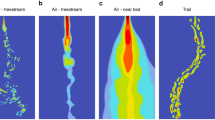Summary
-
1.
The pupal eclosion rhythm imSarcophaga argyrostoma was compared with the photoperiodic induction of diapause in the same species. The eclosion rhythm is controlled by a circadian system which free-runs in continuous darkness (DD), after exposure to light/dark cycles (LD) or to continuous light (LL), with an endogenous period, τ, close to 24 h. InLD cycles photoperiod controls the rate of larval development, and which eclosion gates are used by the emerging flies.
-
2.
Sequential transfer of cultures fromLL to DD, or exposure to a 7 h delay in the light cycle at different ages, showed that the response (in terms of initiation and phase control of the eclosion rhythm) was maximal with young larvae, less with older larvae, and only marginal with the early intra-puparial stages. Older intrapuparial stages (developing adults) appear to show a renewed responsiveness to light pulses.
-
3.
Phase response curves for the eclosion rhythm were “weak” or Type 1 with 1 h pulses; those for 8 h and 12 h pulses were “strong” or Type 0. After light periods in excess of about 12 h the eclosion peaks occurred at characteristic time (11.3+modulo τ h) after the light-off or “dusk” signal, provided that theLD cycles were experimentally discontinued before the end of larval development.
-
4.
Cultures transferred fromLL into a dark (D) and a final light (L) period which together added up to a value (D+L) close to 24 or 48 h gave rise to highly rhythmic eclosion patterns. Those in whichD + L values were close to 36 or 60 h, however, were far less coherent. This difference is attributed to the multi-oscillator construction of the circadian system, and its internal temporal organisation.
-
5.
A phase response curve for the photoperiodic oscillator was determined for 15 min resetting pulses by the use of 3-point “skeleton” photoperiods. Like the 1 h response curve for pupal eclosion, this was of the “weak” type with small “amplitude” phase changes.
-
6.
The similarities between the eclosion rhythm and the photoperiodic oscillator inS. argyrostoma (same responsive period, same phase response curve, same phase relationships to driving light cycles) are discussed. The two systems are considered to be sufficiently alike for the overt system (eclosion) to be used as a measure of phase in the analysis of the photoperiodic clock, as recommended by Pittendrigh and Minis (1964).
Similar content being viewed by others
References
Aschoff, J.: Desynchronization and resynchronization of human circadian rhythms. Aerosp. Med.40, 844–849 (1969)
Bateman, M.A.: The effect of light and temperature on the rhythm of pupal ecdysis in the Queensland fruit flyDacus (Strumeta) tryoni (Frogg.). Austr. J. Zool.3, 22–33 (1955)
Bünning, E.: The physiological clock. Third English edit. Berlin-Heidelberg-New York: Springer 1973
Gibbs, D.: Reversal of pupal diapause inSarcophaga argyrostoma by temperature shifts after puparium formation. J. Insect Physiol.21, 1179–1186 (1975)
Hamner, W.M.: Circadian control of photoperiodism in the house finch demonstrated by interrupted-night experiments. Nature (Lond.)203, 1400–1401 (1964)
Hoffmann, K.: Circadiane Periodik bei Tupajas (Tupaia glis) in konstanten Bedingungen. Zool. Anz., Suppl.33, 171–177 (1969)
Minis, D.H.: Parallel peculiarities in the entrainment of a circadian rhythm and photoperiodic induction in the pink bollworm (Pectinophora gossypiella). In: Circadian clocks (ed. J. Aschoff), p. 333–343. Amsterdam: North-Holland 1965
Pittendrigh, C.S.: On the mechanism of entrainment of a circadian rhythm by light cycles. In: Circadian clocks (ed. J. Aschoff), p. 277–297. Amsterdam: North Holland 1965
Pittendrigh, C.S.: The circadian oscillation inDrosophila pseudoobscura pupae: A model for the photoperiodic clock. Z. Pflanzenphysiol.54, 275–307 (1966)
Pittendrigh, C.S.: Circadian Systems, I. The driving oscillation and its assay inDrosophila pseudoobscura. Proc. nat. Acad. Sci. (Wash.)58, 1762–1767 (1967)
Pittendrigh, C.S.: Circadian surfaces and the diversity of possible roles of circadian organization in photoperiodic induction. Proc. nat. Acad. Sci. (Wash.)69, 2734–2737 (1972)
Pittendrigh, C.S., Bruce, V.G., Kaus, P.: On the significance of transients in daily rhythms. Proc. nat. Acad. Sci. (Wash.)44, 965–973 (1958)
Pittendrigh, C.S., Eichhorn, J.A., Minis, D.H., Bruce, V.G.: Circadian systems VI. Photoperiodic time measurement inPectinophora gossypiella. Proc. nat. Acad. Sci. (Wash.)66, 758–764 (1970)
Pittendrigh, C.S., Minis, D.H.: The entrainment of circadian oscillations by light and their role as photoperiodic clocks. Amer. Nat.98, 261–294 (1964)
Pittendrigh, C.S., Minis, D.H.: The photoperiodic time measurement inPectinophora gossypiella and its relation to the circadian system in that species. In: Biochronometry, pp. 212–250 (ed. M. Menaker). Washington: National Academy of Sciences 1971
Saunders, D.S.: Circadian clock in insect photoperiodism. Science168, 601–603 (1970)
Saunders, D.S.: The temperature-compensated photoperiodic clock “programming” development and pupal diapause in the flesh-fly,Sarcophaga argyrostoma. J. Insect Physiol.17, 801–812 (1971)
Saunders, D.S.: Circadian control of larval growth rate inSarcophaga argyrostoma. Proc. nat. Acad. Sci. (Wash.)69, 2738–2740 (1972)
Saunders, D.S.: The photoperiodic clock in the flesh-fly,Sarcophaga argyrostoma. J. Insect Physiol.19, 1941–1954 (1973)
Saunders, D.S.: ‘Skeleton’ photoperiods and the control of diapause and development in the flesh-flySarcophaga argyrostoma. J. comp. Physiol.97, 97–112 (1975)
Truman, J.W.: Circadian rhythms and physiology with special reference to neuroendocrine processes in insects, pp. 111–135 Proc. int. Symp. circadian Rhythmicity (Wageningen) (1971)
Truman, J.W.: Involvement of a photoreversible process in the circadian clock controlling silkmoth eclosion. Z. vergl. Physiol.76, 32–40 (1972)
Truman, J.W., Riddiford, L.M.: Neuroendocrine control of ecdysis in silkmoths. Science167, 1624–1626 (1970)
Williams, C.M., Adkisson, P.L.: Physiology of insect diapause. XIV. An endocrine mechanism for the photoperiodic control of pupal diapause in the oak silkworm,Antheraea pernyi. Biol. Bull.127, 511–525 (1964)
Winfree, A.T.: Integrated view of resetting a circadian clock. J. theoret. Biol.28, 327–374 (1970)
Winfree, A.T.: On the unclocklike behaviour of biological clocks. Nature (Lond)253 315–319 (1975)
Author information
Authors and Affiliations
Additional information
This work was supported by a grant from the Science Research Council. It is also a pleasure to thank Mrs. Helen MacDonald for technical assistance, and Mr. N. Mackay for making the recording apparatus.
Rights and permissions
About this article
Cite this article
Saunders, D.S. The circadian eclosion rhythm inSarcophaga argyrostoma: Some comparisons with the photoperiodic “clock”. J. Comp. Physiol. 110, 111–133 (1976). https://doi.org/10.1007/BF00656785
Received:
Issue Date:
DOI: https://doi.org/10.1007/BF00656785




